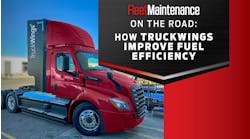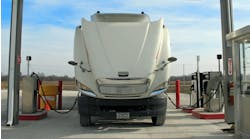With the acceleration of electrification, the Class 1-8 vehicle landscape will look vastly different in just six years. By 2027, the size of the global commercial electric vehicle market will swell to $2.55 trillion, a 62% increase over the 2020 share of $1.57 trillion, according to Precedence Research.
That means brand new equipment—and dozens of new terms, acronyms, and jargon to learn. And accurate and proper communication will be crucial to keep drivers, fleet owners and fleet maintenance personnel on the same page when discussing day-to-day operations and handling any issues.
To help navigate the electrification lexicon, charging solution provider Versinetic has created an interactive table, based of Mendeleev periodic table of elements. It includes 100+ new definitions to know, like load balancing (“the ability of chargers to 'balance' their energy usage against each other an other devices to prevent a grid overload”), along with nuggets of information regarding topics such as depreciation, which Verisnetic noted happens slower with EVs than their ICE counterparts.
It should be noted Versinetic is based in Birmingham, England, so a few terms may be different and relate to U.K. incentives and taxes, but overall, the table appears to be a good primer for those unfamiliar with the sector.
For instance, they can distinguish between fast charging, rapid charging, and ultra-fast charging.
According to Versinetic:
- Fast charger: A charging speed between 7kW and 22kW. While faster than charging from the domestic mains, “Fast” charging isn’t very fast. Many cars will take between three and ten hours to fast charge.
- Rapid charger: A charging speed of 43 kW or more. Rapid charging will typically charge an EV in under an hour.
- Ultra-Fast Charger: charging speeds of 150 kW or more. Allows very fast charging times. The majority of car batteries cannot currently cope with this charging speed, although a Lotus EV hyper car was charged at 800kW, so maybe this kind of speed will be more common before long.
Then there’s the granny charger— “a car charger that can be plugged into a mains socket in a house. They’re called Granny Chargers because the most often time they’re used is when visiting a family member who lets you charge up your car for your return journey. Often they only produce 2kW of power, so charging is very slow.”
Check out the full Versinetic EV acronyms periodic table here.




